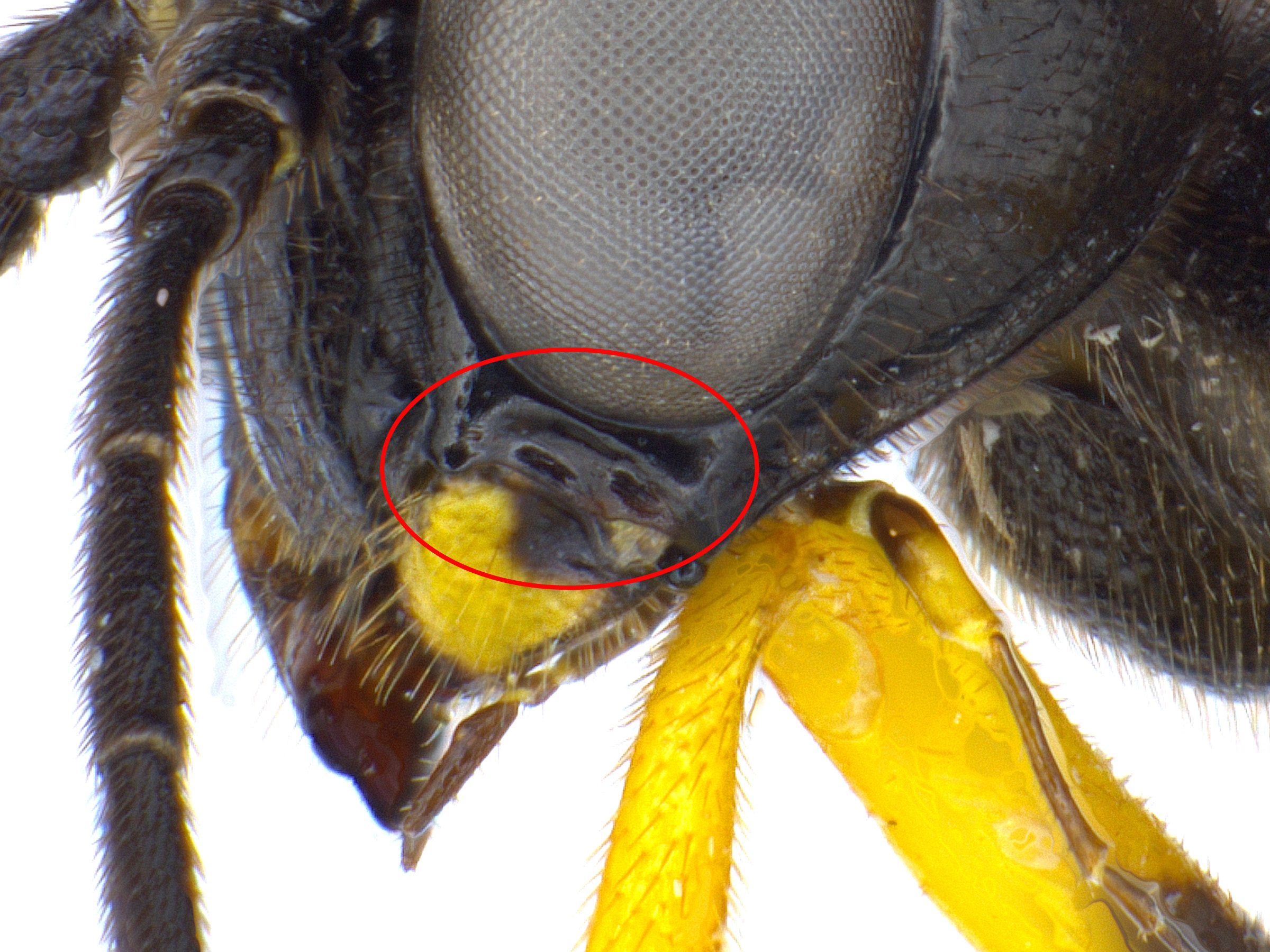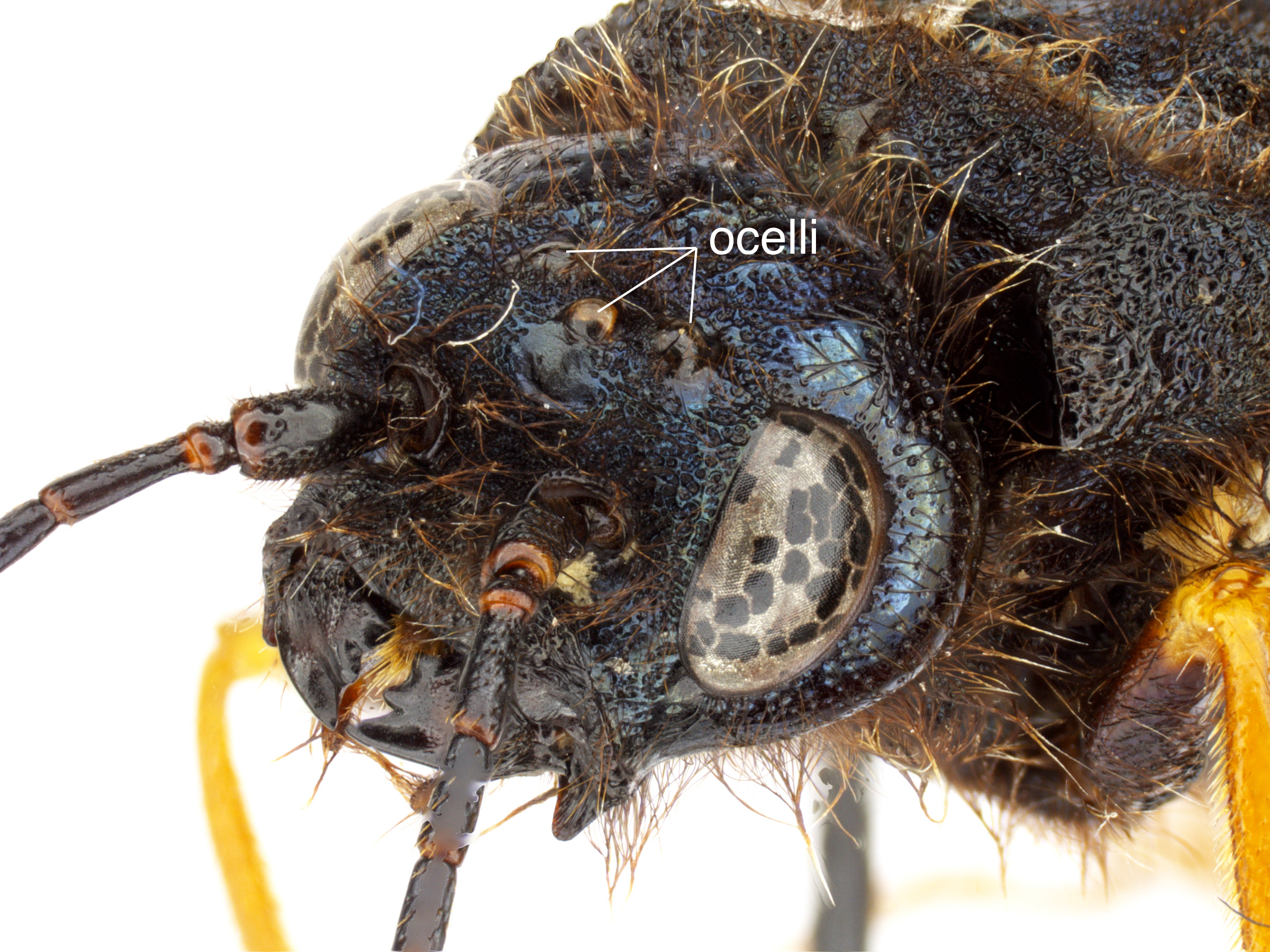Family: Tenthredinidae
Family common name: common sawflies
Subfamily: Selandriinae
Tribe: Heptamelini
Genus: Heptamelus Haliday, 1855
Subgenera: none
The Tenthredinidae are the most species-rich family and are found throughout the world, in all continents but Antarctica. They are known as the “common sawflies.” They can generally be recognized by a cylindrical body and long, segmented antennaeantenna:
the sensory organ emerging from the front of the head, usually between the compound eyes and above the clypeus; includes the flagellum, scape and pedicel
 . Otherwise, they come in a variety of colors, sizes, and forms (Goulet 1992Goulet 1992:
. Otherwise, they come in a variety of colors, sizes, and forms (Goulet 1992Goulet 1992:
Goulet H. 1992. The genera and subgenera of the sawflies of Canada and Alaska: Hymenoptera. Symphyta. The insects and arachnids of Canada. Part 20. Agriculture Canada Publication.).
Sawflies in the Selandriinae subfamily are relatively small and slender. The range of Selandriinae is worldwide; it occurs on all continents except Antarctica (Goulet 1992Goulet 1992:
Goulet H. 1992. The genera and subgenera of the sawflies of Canada and Alaska: Hymenoptera. Symphyta. The insects and arachnids of Canada. Part 20. Agriculture Canada Publication.). It is the most common and diverse group of tenthredinids in tropical regions, particularly in Central America, South America, and Southeast Asia (Smith 1969eSmith 1969e:
Smith DR. 1969e. Nearctic Sawflies. II. Selandriinae: Adults (Hymenoptera: Tenthredinidae). Technical Bulletin, U.S. Department of Agriculture 1398: 1-48.). Selandriinae contains the only known sawflies that feed on non-vascular plants, specifically ferns (Smith et al. 2013Smith et al. 2013:
Smith DR, Janzen DH and Hallwachs W. 2013. Food plants and life histories of sawflies of the families Argidae and Tenthredinidae (Hymenoptera) in Costa Rica, a supplement. Journal of Hymenoptera Research 35: 17-31. https://doi.org/10.3897/JHR.35.5496). The subfamily can be distinguished from other subfamilies by wing venationvenation:
the network of veins on a wing
(Goulet 1992Goulet 1992:
Goulet H. 1992. The genera and subgenera of the sawflies of Canada and Alaska: Hymenoptera. Symphyta. The insects and arachnids of Canada. Part 20. Agriculture Canada Publication.).
Heptamelus is monotypicmonotypic:
describes having only one representative; ex. a genus that includes only one species
in North America (Taeger et al. 2010Taeger et al. 2010:
Taeger A, Blank SM, and Liston AD. 2010. World Catalog of Symphyta (Hymenoptera). Zootaxa 2580: 1-1064.). Heptamelus dahlbomi is small, about 5 mm in length, with a black body and light yellow-colored legs. This species is a fern-feeding sawfly (Smith 1969eSmith 1969e:
Smith DR. 1969e. Nearctic Sawflies. II. Selandriinae: Adults (Hymenoptera: Tenthredinidae). Technical Bulletin, U.S. Department of Agriculture 1398: 1-48.).
There are 37 described extantextant:
in existence; opposite of extinct
species worldwide. One introduced species occurs in North America (Taeger et al. 2010Taeger et al. 2010:
Taeger A, Blank SM, and Liston AD. 2010. World Catalog of Symphyta (Hymenoptera). Zootaxa 2580: 1-1064.).
Subfamily characters
 vein Rs+M curved near intersection with veinvein:
vein Rs+M curved near intersection with veinvein: Sc+R (Smith 1969eSmith 1969e:
Sc+R (Smith 1969eSmith 1969e: vein M meeting Sc+R basalbasal:
vein M meeting Sc+R basalbasal: vein 2r-m present (Goulet 1992Goulet 1992:
vein 2r-m present (Goulet 1992Goulet 1992:Genus characters
 margin shallowly notched (Smith 1969eSmith 1969e:
margin shallowly notched (Smith 1969eSmith 1969e: length about equal to the diameter of the front ocellusocellus:
length about equal to the diameter of the front ocellusocellus: (Smith 1969eSmith 1969e:
(Smith 1969eSmith 1969e: twice as long as wide (Goulet 1992Goulet 1992:
twice as long as wide (Goulet 1992Goulet 1992: with 5 or 6 flagellomeres; 7 or 8 segments total (Goulet 1992Goulet 1992:
with 5 or 6 flagellomeres; 7 or 8 segments total (Goulet 1992Goulet 1992: cellcell:
cellcell: 1M narrowed at apexapex:
1M narrowed at apexapex: stigma as wide as length of veinvein:
stigma as wide as length of veinvein: 2r (Goulet 1992Goulet 1992:
2r (Goulet 1992Goulet 1992: veins M and cu-a meeting on veinvein:
veins M and cu-a meeting on veinvein: M+Cu1 (Goulet 1992Goulet 1992:
M+Cu1 (Goulet 1992Goulet 1992: anal crossveinanal crossvein:
anal crossveinanal crossvein: with relatively long inner tooth (Smith 1969eSmith 1969e:
with relatively long inner tooth (Smith 1969eSmith 1969e:Heptamelus can be confused with similar species in the subfamily Selandriinae. It can be distinguished from most other genera by the fewer number of antennal segments and combination of wing venationvenation:
the network of veins on a wing
characteristics (Smith 1969eSmith 1969e:
Smith DR. 1969e. Nearctic Sawflies. II. Selandriinae: Adults (Hymenoptera: Tenthredinidae). Technical Bulletin, U.S. Department of Agriculture 1398: 1-48., Goulet 1992Goulet 1992:
Goulet H. 1992. The genera and subgenera of the sawflies of Canada and Alaska: Hymenoptera. Symphyta. The insects and arachnids of Canada. Part 20. Agriculture Canada Publication.).
none
North American hosts for H. dahlbomi are not known. Hosts in Europe include ferns Athyrium filix-femina (common lady fern), Athyrium distentifolium (alpine lady fern), Blechnum (hard fern), and Polypodium (Goulet 1992Goulet 1992:
Goulet H. 1992. The genera and subgenera of the sawflies of Canada and Alaska: Hymenoptera. Symphyta. The insects and arachnids of Canada. Part 20. Agriculture Canada Publication., Liston et al. 2018Liston et al. 2018:
Liston AD, Varing;rdal H, and Prous M. 2018 New and poorly-known sawflies (Hymenoptera, Tenthredinoidea) from Sweden, with taxonomic notes on Palaearctic [sic] Heptamelus species described by Swedish authors. Entomologist Tidskrift 139: 119-131.).
Female H. dahlbomi deposit eggs into the lower part of the frond where it meets the petiolepetiole:
stalk or stem; used to describe basal vein stalk in wing OR basal stalk of a leaf.
. LarvaeLarva:
the immature stage of holometabolous insects
 are grayish-white and feed on the petiolepetiole:
are grayish-white and feed on the petiolepetiole:
stalk or stem; used to describe basal vein stalk in wing OR basal stalk of a leaf.
, causing damage to the leaf growth above (Vikberg and Liston 2009Vikberg and Liston 2009:
Vikberg V and Liston AD. 2009. Taxonomy and biology of European Heptamelini (Hymenoptera, Tenthredinidae, Selandriinae). Zootaxa 2112: 1-24.).
Heptamelus dahlbomi was likely introduced to North America, but it is not clear from where or how (Liston et al. 2018Liston et al. 2018:
Liston AD, Varing;rdal H, and Prous M. 2018 New and poorly-known sawflies (Hymenoptera, Tenthredinoidea) from Sweden, with taxonomic notes on Palaearctic [sic] Heptamelus species described by Swedish authors. Entomologist Tidskrift 139: 119-131.). No males in native or introduced range are recorded, suggesting this species is parthenogeneticparthenogenesis:
a type of sexual reproduction where embryos are produced from unfertilized eggs
(Vikberg and Liston 2009Vikberg and Liston 2009:
Vikberg V and Liston AD. 2009. Taxonomy and biology of European Heptamelini (Hymenoptera, Tenthredinidae, Selandriinae). Zootaxa 2112: 1-24.).
World: Two species’ ranges include Europe. The remainder are recorded from the Russian Far East, and East and Southeast Asia (Taeger et al. 2010Taeger et al. 2010:
Taeger A, Blank SM, and Liston AD. 2010. World Catalog of Symphyta (Hymenoptera). Zootaxa 2580: 1-1064., Liston et al. 2018Liston et al. 2018:
Liston AD, Varing;rdal H, and Prous M. 2018 New and poorly-known sawflies (Hymenoptera, Tenthredinoidea) from Sweden, with taxonomic notes on Palaearctic [sic] Heptamelus species described by Swedish authors. Entomologist Tidskrift 139: 119-131.).
North America: Heptamelus dahlbomi occurs in British Columbia, Maryland, and Virginia (Vikberg and Liston 2009Vikberg and Liston 2009:
Vikberg V and Liston AD. 2009. Taxonomy and biology of European Heptamelini (Hymenoptera, Tenthredinidae, Selandriinae). Zootaxa 2112: 1-24.).
Map data from: GBIF.org (29 October 2019) GBIF Occurrence Download Heptamelus and the Smithsonian National Museum of Natural History Entomology Collection (USNM)
Details about data used for maps can be found here.